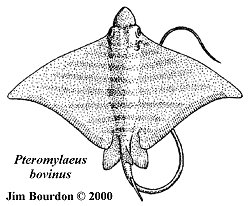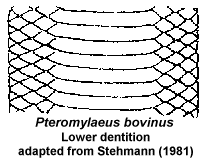| |

 The bull rays are a small to medium-sized genus inhabiting warm-temperate and tropical seas. Primarily found in coastal waters (alone or in groups), they are occasionally noted offshore. Preferring soft bottoms, the genus feeds upon bottom-living crustaceans and mollusks. Similar to Myliobatis, the disc is lozenge-shaped, but the single-lobed snout is more elongated, and the stinging barb (up to four) is set apart from the dorsal fin.
The bull rays are a small to medium-sized genus inhabiting warm-temperate and tropical seas. Primarily found in coastal waters (alone or in groups), they are occasionally noted offshore. Preferring soft bottoms, the genus feeds upon bottom-living crustaceans and mollusks. Similar to Myliobatis, the disc is lozenge-shaped, but the single-lobed snout is more elongated, and the stinging barb (up to four) is set apart from the dorsal fin.
 Compagno (1999) recognized two species. Pteromylaeus bovinus (GEOFFROY ST. HILAIRE, 1817), the Bull ray (DW to 1.8 m), is an Eastern Atlantic species represented in waters from Portugal to South Africa (including the Mediterranean) and extend into southwestern Indian Ocean. P. asperrimus (GILBERT, 1898), the Rough eagle ray (DW to .8 m) is a less well known species from tropical waters of the Eastern Central Pacific (Panama and the Galapagos Islands).
Compagno (1999) recognized two species. Pteromylaeus bovinus (GEOFFROY ST. HILAIRE, 1817), the Bull ray (DW to 1.8 m), is an Eastern Atlantic species represented in waters from Portugal to South Africa (including the Mediterranean) and extend into southwestern Indian Ocean. P. asperrimus (GILBERT, 1898), the Rough eagle ray (DW to .8 m) is a less well known species from tropical waters of the Eastern Central Pacific (Panama and the Galapagos Islands).
| The dental configuration includes one elongated, median file and three lateral files on each side (refer to figure 2). The only illustration I found for this species was included by Stehmann (without comment) for P. bovinus (aka Myliobatis bovina). It appears very similar to Myliobatis freminvillii LESUEUR, 1824, except that the median file is more elongated and the lateral files appearing nearly four-cornered. |
 |
|